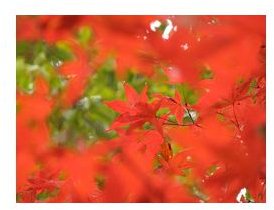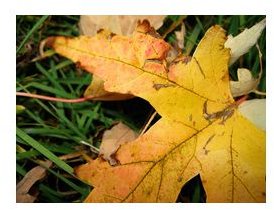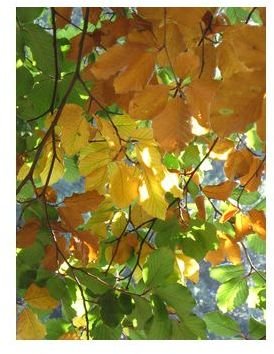Fall Photography - Tips on How to Take the Best Autumn Photos
It’s mid-October and the sunny days of happy beach snapshots and pastoral woodland panoramas are behind us, but its far from time to pack away your outdoor gear for the year, because chances are that the most beautiful scenes to be photographed are just now unfolding all around you.
To get the most out of your fall photography, try the following simple tips for vivid, attention-grabbing seasonal snaps.
Autumn Lighting
Probably more than any other season, Autumn keeps photographers on their toes. Bright sun, clouds, frost, rain, snow, and wild winds can all strike at anytime and sometimes even all at once, which is why it’s critical for a photographer to learn to work with what nature provides, starting with that most fundamental of all elements, light.
Shoot while the Sun is Shining. When the sun is high in the sky with not a cloud in sight, it isn’t the time to try to capture the brooding mood that personifies the season, so stick to the wider pictures that showcase the colors of the landscape as a whole. Nix the close-ups and find yourself a scene. Try putting the trees between you and the sun to really make their leaves glow. But remember, if your background is a bright sky, you may need to compensate with a +1 stop to keep from losing the fine details of the leaves in under exposure.
Shoot when it’s Overcast. The best part of shooting landscapes in October is that there’s no wrong time to snap away. The overcast days that would normally drive a photographer back inside are actually the very best times capture the rich contrasts in foliage color while tingeing your compositions with the slight air of melancholy that lends a composition emotional depth. Use the soft light of these days to its best effect by seeking shots in which shadows interact with light, such as leaves under the silhouette of branches. Again, remember to adjust your exposure. If you’re a shooting leaves against a shadowy background, dial a -1 stop.
Shoot in the Twilight. Sunrise and sunset are the best times of day to shoot outdoors. The light’s low angle picks out shadows and emphasizes a myriad of natural textures that not evident in the day’s full light. If you know the terrain, stake out a vantage point to maximize your views of the shadows gradually shifting and playing over the ground so that you don’t need to relocate right in the middle of the light show. It should also be noted that setting off the reds and yellows of autumn leaves with a backdrop of the same often has breath-taking results. These sorts of setups are especially effective with a little color enhancement on your part.
Vibrant Color

Vibrant colors are the key to capturing autumn in all it splendor, so go out prepared… or be ready to Photoshop your results appropriately.
Filter your Lens. Use ’em if you’ve got ’em. Filters are falling out of style with the Photoshop generation, but they still get the job done quickly and eloquently. Depending on the color of the foliage you’re shooting, you may want to use a red-enhancing filter to intensify both reds and oranges and increase the intensity of the blues in the sky. A B+W 491 Enhancing filter is the classic choice for autumn shots. An 81A or 81B orange-warming filter is another way to give changing leaves a warm glow. And of course, any time you’re shooting outdoors, a polarizing filter is recommended. A polarizing filter will remove stray motes of light and deepen the blues of the sky.
Play with your Exposure. If the light is washing the color out of your leaves, dial back the exposure for deep saturation. Also, remember to shoot in the RAW format, which will allow you a greater range of color control during later editing.
Play with your White Balance. When you’re looking for a dramatic shot and you have no control over your lighting, it’s time to ditch your camera’s automatic white balance. If your camera includes white balance presets, try selecting the next step down from the default (usually designated “cloudy”). If your camera is a higher-end model with manual Kelvin adjustments, increase the setting slowly until you’ve hit your desired effect.
Photo Composition

Of course, even with the perfect lighting and color, your photos are only as good as their subject matter.
Look for the Contrast. Accentuate the variety of fall colors by framing one against the other. Find the red leaf in the midst of golden leaves. Shoot the golden leaves against the blue of the sky. Arrange a bouquet of fallen leaves on the green grass. Juxtapose a variety of colors and textures, while remembering to…
Keep it Simple! Just as too many cooks spoil the pot, too many visual elements are just as certain to ruin to the photo. Limit the number of elements and subjects in your compositions to what you can easily comprehend in a glance. It runs counter to logic, but the human eye lingers longer over the simpler shot while often “sliding off” more intricate shots. So stick to a maximum of three or four fields of color or texture at any one time.
Change your Point of View. Your first impulse on finding a beautiful scene will be to snap the shot as you first see it - composed like a portrait, but for lack of a human subject. However, landscape photography frequently fails to “pop,” especially among beginners, so seek out fresh takes on the scenery. Try bring your lens in close to shoot one leaf at time. Climb up and shoot the leaves as they’ve fallen on the ground. Lay on your back and shoot the treetops from the ground up. If you must shoot traditional portrait-style landscape compositions
Add some Sparkle. Water droplets, ice, and frost can all add eye-catching texture to photos. While these effects may be naturally occurring, you can make your life easier by packing a plant mister in with your camera. Just make a point of photographing anything reflective in light diffused by trees or light cloud cover.
Inject some Motion. Once you’ve exhausted the landscape shots, it may be time to take the setup to the next level to add a professional polish to your work. Capturing autumn foliage as it drifts earthward is an effective way to reinvigorate a landscape you’ve shot before. Use a wide aperture to lightly blur the background until your foreground stands out, then shoot with a shutter speed between 1/2 and 1/30, depending on the speed of the leaves’ fall to capture a sense of motion. This is especially effective on overcast days.
Elizabeth Lawrence said it best. “Even if something is left undone, everyone must take time to sit still and watch the leaves turn.” Make the time this season to enjoy the colors and hone your skills with photos you’re sure to enjoy for year to come!
